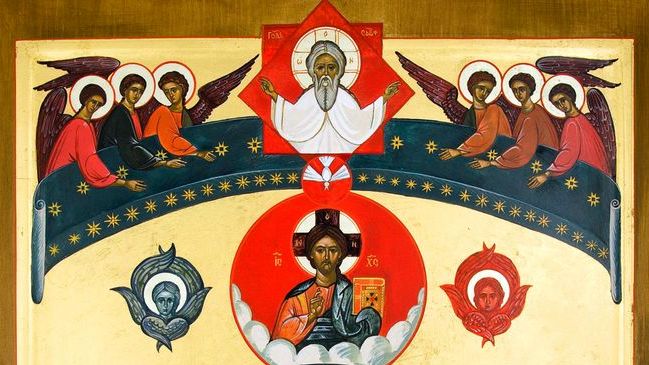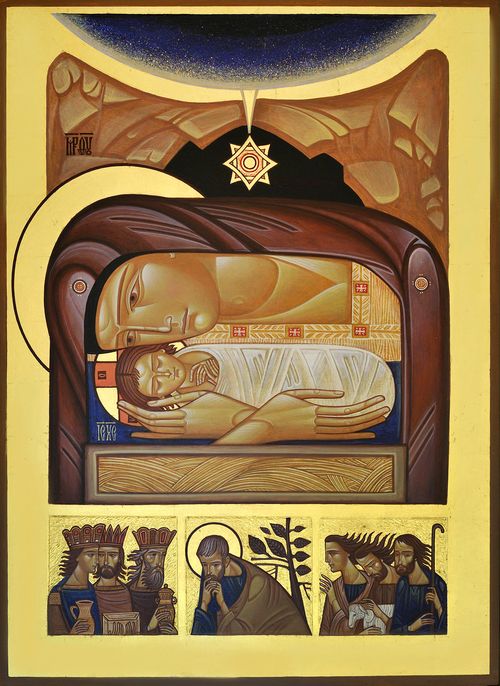Should the icon be modernized?
The Day talked to art historian Roman Yatsiv
Since the independence, many churches have been built in Ukraine. Therefore, there has been a great demand for church painters, and especially icon painters. Unfortunately, one hears quite often that modern icons do not reach the soul. What is more, they are too reminiscent of secular paintings... Some people even say that painting holy images has turned into a purely money-making business for some artists... So what is the contemporary icon like? Does icon painting require academic education? Are there dedicated departments in art academies which teach the basics of icon painting? Does the artistic quality of icon painting always depend on the spiritual qualities of the artist? And, finally, do modern icon painters need to combine tradition and innovation? We discussed all these issues with art historian, vice-rector of Lviv National Academy of Arts Roman Yatsiv.
ON THE PHENOMENON OF UKRAINIAN RELIGIOUS PAINTING AND ICON PAINTING
“The topic of modern Ukrainian icon painting is quite broad and can be viewed in several analytical projections,” Professor Yatsiv said. “The first of them is the public demand for a new icon that would fit modern church architecture and stadial development of church liturgy which is organically linked to the direct practice of worship. The second projection may be created by canonicality of the icon’s ideological and semantic content as well as the evolution of different icon painting types itself which should fit modern theological interpretation of the Scripture. Yet another analytical projection can be found in a purely professional (expert) evaluation of the icon as a genre of sacred art, which develops just as intensely as other modern art genres. In order to cover the essential issues of functioning of the contemporary Ukrainian icon, one must consider each of these aspects.”
In general, how old is the icon painting technology, and where did it come from?
“The icon painting technology evolved starting in the early Christian era, but it experienced the greatest number of improvements in the Byzantine age. Since icon painting was previously carried out by monks in monasteries, the very methods of ground preparation (using levkas) and paint recipes were fairly conservative for a long time. Of course, these technologies did undergo some changes over the centuries, though even many contemporary painters try to stick to the old, time-tested, recipes. However, we see today modern materials used alongside the classic techniques, first of all the acrylic paint on various grounds (surfaced wood or cloth), depending on the functional purpose of the work (it may be destined for the iconostasis in a church, for a private residence or a public institution, or for exhibiting). According to the icon’s purpose, the artist creates the Image’s structure and fills it with a certain ideological and symbolic content.”

SAINTS OLHA AND VOLODYMYR BY ROMAN VASYLYK
What is the tradition of specifically Ukrainian icon painting made up of?
“Taking into account previous historical periods, the tradition of Ukrainian icon painting is created by its organic unity with the overall spiritual and cultural climate in Ukraine, with moral and value priorities of our people, and even with certain political events. Therefore, for instance, Ukrainian icon painting of the Renaissance and especially Baroque time is considered democratic in spirit, in its adherence to Christian ethics. The tradition of Ukrainian icon painting was created by the sum of cultural and regional differences, which in turn were produced by certain features of the people’s life as well as those of political elites. In this case, we must consider every artwork or entire phenomenon in a very specific historical, and with it, environmental context.
“The phenomenon of Ukrainian icon painting has also to do with the fact that the concept of tradition has never stopped the process of renewal of ideas and forms which that art relies on. When certain rigidity took hold at some points in time, we always had artists appearing who suggested a different way of development, and usually it was associated with important social processes in the life of the Ukrainian nation. It is seen most clearly in the so-called folk school of Ukrainian icon painting.”
Is there a difference between religious painting and icon painting?
“The difference between icon painting and religious painting lies in their different ideological and spiritual bases. The icon has a metaphysical nature and is aimed at deep internal human feelings, while the religious painting interprets certain texts of the Bible, referring not only to the Idea of the Christian faith, but also to the plotlines of the Old or New Testaments. Only in some areas of Christian symbols (meanings) can religious paintings and icons approach each other, but even then, their Image structures are different.”
Do contemporary icons use contemporary themes?
“Spiritual and aesthetic nature of icons includes not only metaphysical promises, but theosophic and even social and ethical responses to their time’s challenges as well. It is known that many of the icons of the past present certain accounts of reality, most frequently it is moral value deformations and vices plaguing society. In the era of modernism, icon painting underwent significant secularization, absorbing some polarly opposite spiritual and cultural doctrines of the time, including even traces of atheistic consciousness. In the post-Communist era, we have seen icon painting overcoming the severe consequences of the materialist worldview that left its footprints in some works of the religious art created in the later 20th century, as it has been trying to return to the basic paradigm of Christian art as such. Therefore, the penetration of certain reminiscences of new historical reality into the contemporary icon is quite justified in terms of tradition. The contemporary themes have been emerging particularly often in recent years, when the Ukrainian nation is once again fighting the Muscovite invaders, the historic enemy of Ukraine. The theme of war and heroism is often transformed into that classic image of the Cossack Mamai and fits into the other icon painting motifs, like the Intercession of the Virgin, St. George, St. Michael, the Crucifixion of Christ and others. In this way, the images of our contemporaries (for example, the Heavenly Hundred) are glorified.”
HOW PEOPLE BECOME ICON PAINTERS THESE DAYS
Can you please name the brightest representatives of the contemporary Lviv icon painting school?
“The most prominent contemporary representatives of icon painting include, in particular, Roman Vasylyk, Kost Markovych, Liubov Yatskiv, Ivanka Krypiakevych, Sviatoslav Vladyka, Dmytro Horditsa, Andrii Vynnychuk, Danylo Movchan, and Uliana Tomkevych. We also have an unorthodox group of artists who are guided by the tradition of folk icon, including Roman Zilinko, Ostap Lozynsky, Uliana Nyshchuk-Borysiak, Levko Skop, and Tetiana Duman. Equally interesting treatments of icon tradition are offered by even younger painters, such as Ivanka Demchuk, Sofia Bilyk, Olha Kravchenko, and Maria Ivaniuta.”

CHRISTMAS BY LIUBOV YATSKIV
The department of sacred art of Lviv National Academy of Arts is the only department of its kind in Ukraine. What else is special about it?
“The department annually admits a dozen first-year students, most of them well-motivated to work in precisely this branch of art. Soon enough, the dynamics of the educational process shows the students that the sacred art is significantly different from all other branches of fine or decorative arts. It requires more careful study of the tradition and mastery of key stages of the Christian art with its sophisticated symbolic and semantic system. From the very beginning, one should understand the iconographic types of images, but most of all, cultivate ethical virtues without which no painter can develop in this creative vocation. Some of our students are monks or graduates of other schools who have discovered in themselves a desire and ability to work in this field. To develop a professional worldview, our department’s curriculum provides not only for hands-on workshops, but also for in-depth courses in theology and art history. Meanwhile, the department itself has become known in Ukraine and beyond since it was founded 20 years ago. This is evidenced by the fact that we have had international students coming from countries including Poland, France, and Brazil. The department of sacred art initiated the International Icon Painting Plein-Air in the villages of Nowica (Poland) and Zamlynnia (Ukraine), after which exhibitions take place in many Ukrainian and Polish cities. There have been eight plein-airs so far with a large number of participants. Another ambitious initiative of the department was the creation of the Ukrainian Union of Icon Painters in 2012, which enables coordinated efforts by icon painters from different regions of Ukraine who strive to develop this branch of creative arts.”
ON ARTISTS’ NOVEL INTERPRETATIONS
How do you feel about formal innovations in modern icon painting? In particular, how would you comment on Danylo Movchan’s exhibition “On Paper,” hosted by the Iconart Gallery, which the artist called “my reflections on the icon, the body of Christ, the personal experiences prompted by the sacred art...” Also, we have now some cases of very secular-themed artists entering the field of icon painting. For example, Oleksandr Voitovych’s main theme is female portrait and nudity. Still, he painted several icons for Saints Peter and Paul Garrison Church lately. How productive can such creative combination be?
“Development of a new language in icon painting is a natural process, although it is complex and not always productive. Some artists’ interpretations of canonical images are controversial in nature and not always suitable for those icons that play a role in the liturgy. There are cases where a newly created icon comes into conflict with the environment of the shrine, bringing an aesthetic, and worse still, a spiritual dissonance. However, the classic icon prompts novel interpretations, and religious meanings need modern interpretations as well, and then icon painting continues its development in conjunction with new artistic ideas of the modern era. This is signified by the experiences of prominent artists of the later 20th and early 21st centuries, like Yurii Novosilsky, Yakiv Hnizdovsky, Mykola Bidniak, Omelian Mazuryk, or Petro Kholodny Jr. ‘Reflections on the icon, the personal experiences prompted by the sacred art,’ which is how Movchan described his exhibition ‘On Paper,’ are completely acceptable if the artist has a serious spiritual approach to his creative task. Similarly, I see no issue with artists who are not primarily icon painters entering this field (as in your example of very interesting Lviv artist Voitovych). The key thing in these cases is the personal professional, and even more importantly, ethical responsibility of the creator for such a choice.”
Newspaper output №:
№67, (2016)Section
Culture





